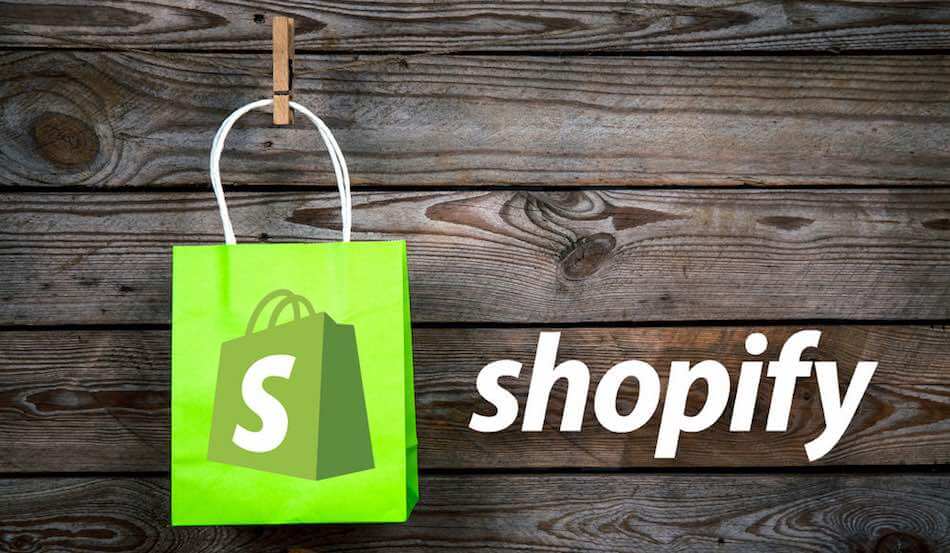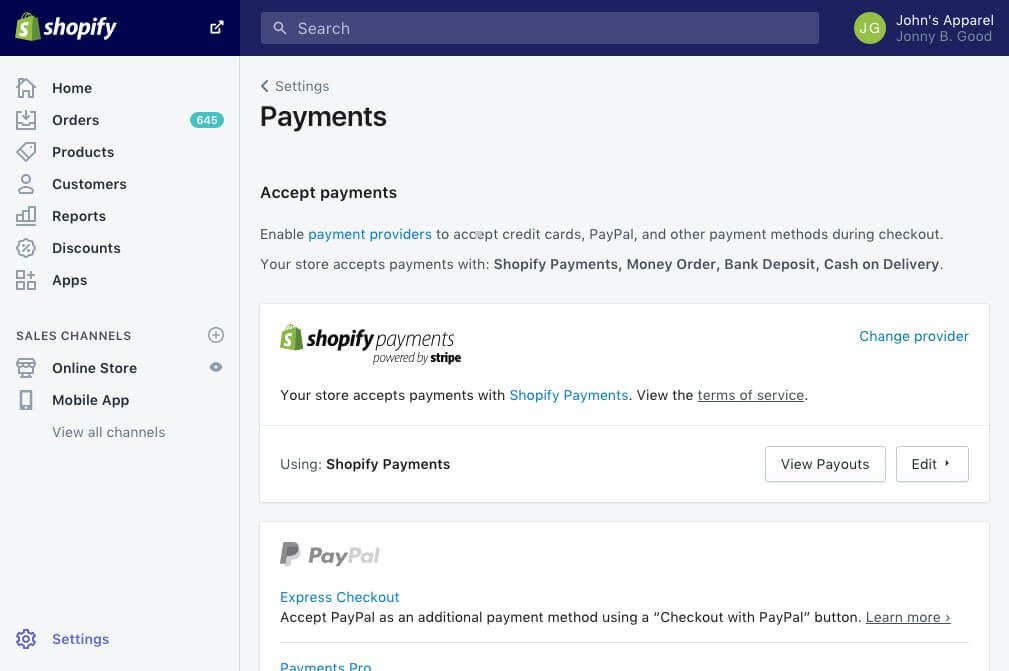What is Shopify?
Shopify is a web application that allows you to create your own online store. It provides you with a wide range of templates that can be customized to meet individual users’ branding requirements, and it allows either physical or digital goods to be sold.
One of the main ideas behind Shopify is that users without much in the way of technical or design skills can create a store without the involvement of a design agency or web developer; however, people who are familiar with HTML and CSS will be pleased to discover that Shopify allows you to edit both, giving you a lot of control over the design of templates.
Because Shopify is a hosted solution, you don’t need to worry about buying web hosting or installing software anywhere; the idea is that pretty much everything you need to build and run your store happens ‘out of the box.’
That said, you can customise a Shopify store to meet more individual requirements through the addition of apps — more on which later — or using custom code.
Shopify is a software as a service (‘Saas’) tool – this means that you don’t own it but rather pay a monthly fee to use it. As long as you have access to a web browser and the internet, you can manage your store from anywhere.

How many people use Shopify? And why does this matter?
According to Shopify the product has
-
been used to power 800,000 stores
-
over 1,000,000 active users
-
generated over $100bn in sales.
Now without getting a mole into Shopify’s accounts department, it’s impossible to verify the accuracy of the above numbers, but it’s fairly safe to say that Shopify is definitely one of the more established e-commerce platforms out there.
This is important because when you choose a hosted solution to build an online store with, you are placing a large amount of trust in the company providing it. There have been instances in the past of similar services closing down in the past – Magento Go being a case in point — resulting in all manner of problems for their users (who had to migrate their stores over to a different platform at relatively short notice).
Shopify’s strong market position and very large user base should make the prospect of financial difficulties for the company less likely, which in turn makes the prospect of a store you host with them suddenly disappearing less likely.
We’ll have a look at what you can do with Shopify shortly – but first, let’s check out the pricing.
Shopify pricing
There are five Shopify pricing plans to choose from:
-
‘Shopify Lite’ – $9 per month
-
‘Basic Shopify’ – $29 per month
-
‘Shopify’ – $79 per month
-
‘Advanced Shopify’ – $299 per month
-
‘Shopify Plus’ – fees are negotiable, but in the region of $2000 per month.
Shopify represents one of the cheaper ways into selling online, with its starter plan, “Shopify Lite” costing $9 per month and allowing you to sell an unlimited number of goods.

Shopify pricing (correct as of April 2019)
However, it’s important to note that the ‘Lite’ plan does not actually allow you to construct a fully-functional, standalone online store: rather, it
-
lets you sell via your Facebook page
-
allows you to use Shopify in a physical location to sell goods or manage inventory
-
gives you access to Shopify’s Buy Button, which allows you to sell goods on an existing website or blog.
The Buy Button works similar to a Paypal ‘Buy Now’ button, but because it links back to Shopify, more sophisticated options regarding tracking orders and their fulfilment status are available. Additionally, you can use a Buy Button to display entire categories of products on another site.
Using the Shopify Buy Button allows you to integrate Shopify into a site built on another platform – for example, Squarespace or WordPress; this is a useful feature for users who are generally happy with their existing website but wish to integrate some Shopify e-commerce functionality onto it.
As you move up the pricing scale, you’ll encounter the ‘Basic Shopify’ plan for $29 per month; the ‘Shopify’ plan for $79 per month and the ‘Advanced Shopify’ plan for $299 per month. Unlike the ‘Lite’ plan, all of these plans do allow you to host a fully functional online store.
Finally, there is is also the ‘Shopify Plus’ plan to consider – this is an ‘enterprise grade’ solution which is designed more with big businesses in mind rather than the average user; it offers advanced features regarding security, APIs and fulfilment.
So what are the main differences between each plans?
Key differences between Shopify plans
Key features to watch out (and not miss by selecting the wrong Shopify plan) are:
-
reporting – professional reporting functionality is only available on the $79 ‘Shopify’ plans and up
-
advanced report builder – advanced reporting tools (which allow you to create custom reports) are only provided on the most expensive ‘Advanced’ and ‘Shopify Plus’ plans
-
gift cards – these are only available on the $79 ‘Shopify’ plans and up
-
real time carrier shipping, which is only available on the most expensive ‘Advanced Shopify’ plan
-
staff accounts – these allow you to give different members of your team different permissions (which is useful for restricting access to sensitive data); you are allowed 2 staff accounts on the ‘Basic Shopify’ plan; 5 on the ‘Shopify’ plan and 15 on the ‘Advanced Shopify’ plan
-
point of sale (POS) functionality – you can’t avail of all POS functionality unless you are on a ‘Shopify’ or higher plan (we’ll discuss point of sale in more depth below).
It’s worth mentioning that you don’t have to pay for plans on a monthly basis – you can pay on an annual or biennial basis. Shopify offers a 10% discount on an annual and a 20% discount on a biennial plans, when they are paid upfront.
Overall Shopify’s pricing structure is fairly consistent with key competing products like Bigcommerce, Squarespace and Volusion; the main difference involves the ‘Lite’ plan really, which whilst not giving you a fully hosted online store, does allow you to make use of many key Shopify features on an another website for a very low monthly fee.
If I had a criticism of Shopify’s pricing structure it would be that some features which you might expect to find on entry level plans — like gift cards and professional reporting — only become available when you opt for a more expensive one (or make use of a paid-for app).
Other solutions, notably Bigcommerce, are considerably more generous with the entry-level feature set, offering a bit more of an ‘all-in-one’ approach.
Let’s take a look at how Shopify actually lets you accept payments for your goods – because this is where some key advantages of using the platform can be found.

Shopify Payments, payment gateways and transaction fees
There are two ways to accept credit card payments on Shopify.
The most straightforward, for users in countries where it is supported, is to use Shopify Payments, Shopify’s built-in payment system.
If you use this, you don’t have to worry about transaction fees at all, which is great. However, there is still a ‘credit card rate’ to consider: in the US, you can expect to pay a rate of between 2.4% and 2.9% of each credit card transaction (plus on some plans, an additional 30c). In other countries, the rate is lower (the UK range of credit card fees, for example, stretches from 1.5% to 2.2%).
The exact rate depends on the type of plan you are on, with the lowest transaction fees (as you might expect) becoming available on the most expensive monthly subscriptions.
Alternatively, you can use a third party ‘payment gateway’ to process card transactions — of which there are over 100 to choose from (far more than are available from competing platforms Bigcommerce, Volusion or Squarespace).
Using a third-party payment gateway requires a bit of configuration – you’ll need to set up a ‘merchant account’ with a payment gateway provider. Depending on the payment gateway provider you use, you can expect to pay a percentage of a transaction fee, a monthly fee or both.
If you use a payment gateway, Shopify will apply a transaction fee as well (of between 0.5% and 2% depending on the Shopify plan you’re on — again, the fee gets lower as the monthly plans get more expensive).
Whether or not it works out cheaper to use Shopify Payments or a payment gateway will depend very much on the kind of payment gateway you’re thinking of using, and the Shopify plan you’re on.
One important thing worth nseooting about Shopify Payments is that it is available only for users based in certain countries.
These are:
-
Australia
-
Canada
-
Germany
-
Hong Kong SAR China
-
Ireland
-
Japan
-
New Zealand
-
Singapore
-
Spain
-
United Kingdom
-
United States
(Note however that Shopify Payments is not available to US territories except Puerto Rico.)
So if you’re not selling from one of those territories then you will have to use another separate payment gateway provider (meaning you’ll definitely need to factor transaction fees into the equation).
As mentioned above however, Shopify integrates with far more payment gateways than other competing products do (over 100 of them), so if you are selling outside of these countries, you should be able to find a payment gateway that’s suitable for your location easily enough.
Now that we’ve gone through pricing and payment functionality, it’s time to discuss how Shopify themes actually look.
Core features of Shopify
As discussed above, the features you get with Shopify vary a bit according to the pricing plan you opt for.
All Shopify plans from $29 (‘Basic Shopify’) and up provide:
-
the ability to sell physical or digital goods, in categories of your choosing and using shipping rates / methods of your choosing
-
a wide range of themes (free and paid) to choose from
-
credit card processing via Shopify Payments or a third party payment gateway
-
integration with Paypal
-
blogging functionality
-
abandoned cart functionality
-
import / export of customer data
-
content management (CMS) functionality
-
search engine optimisation (SEO) functionality
-
discount codes
-
the ability to edit your store’s CSS and HTML
-
a ‘buy now’ button that you can use to sell goods on an another blog or site
-
access to a point-of-sale app
-
the option to create multiple staff accounts (as discussed above, how many you can created depends on the plan you’re on).
-
the option to integrate your store with 100+ payment gateways
-
the ability to print labels for product shipping
-
discounts from couriers on shipping fees (depending on country)
If you opt for the more expensive ‘Shopify’ plan, you also get:
-
gift cards
-
professional reports
-
full point of sale functionality
If you’re on the ‘Advanced Shopify’ plan, on top of all the above you get the following additional features:
-
advanced report building
-
real-time carrier shipping
Finally, there’s Shopify Plus to consider: this is an enterprise-grade version of Shopify, providing features such as
-
guaranteed server uptime
-
API support
-
‘White glove’ level of support via a dedicated ‘Merchant Success Manager’
-
dedicated SSL / IP address
-
advanced security features.
Let’s zoom in on a few key aspects of Shopify that are worthy of particular attention.
Try Shopify Risk Free Now!
